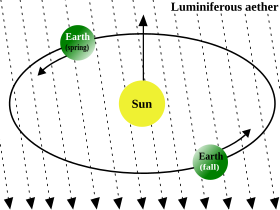
Back Äther (Physik) ALS أثير ناقل للضوء Arabic Эфір (фізіка) Byelorussian Етер (физика) Bulgarian Èter (física) Catalan Éter (fyzika) Czech Эфир (физика) CV Æter (fysikhistorie) Danish Äther (Physik) German Lumporta etero Esperanto

Luminiferous aether or ether[1] (luminiferous meaning 'light-bearing') was the postulated medium for the propagation of light.[2] It was invoked to explain the ability of the apparently wave-based light to propagate through empty space (a vacuum), something that waves should not be able to do. The assumption of a spatial plenum (space completely filled with matter) of luminiferous aether, rather than a spatial vacuum, provided the theoretical medium that was required by wave theories of light.
The aether hypothesis was the topic of considerable debate throughout its history, as it required the existence of an invisible and infinite material with no interaction with physical objects. As the nature of light was explored, especially in the 19th century, the physical qualities required of an aether became increasingly contradictory. By the late 19th century, the existence of the aether was being questioned, although there was no physical theory to replace it.
The negative outcome of the Michelson–Morley experiment (1887) suggested that the aether did not exist, a finding that was confirmed in subsequent experiments through the 1920s. This led to considerable theoretical work to explain the propagation of light without an aether. A major breakthrough was the special theory of relativity, which could explain why the experiment failed to see aether, but was more broadly interpreted to suggest that it was not needed. The Michelson–Morley experiment, along with the blackbody radiator and photoelectric effect, was a key experiment in the development of modern physics, which includes both relativity and quantum theory, the latter of which explains the particle-like nature of light.
- ^ See "Google Scholar 'luminiferous ether'".
- ^ The 19th century science book A Guide to the Scientific Knowledge of Things Familiar provides a brief summary of scientific thinking in this field at the time.